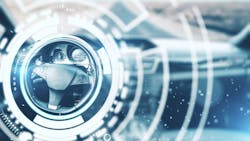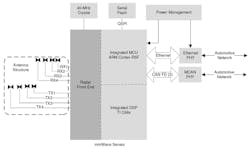Enhanced mmWave Radar Sensor Improves ADAS and Meets New Regulations
Members can download this article in PDF format.
Advanced driver-assistance systems (ADAS) consist of automotive electronic monitoring and control devices that help the driver avoid collisions. These platforms use multiple sensors to detect nearby vehicles and provide information such as distance, direction, and speed that allows the driver to adjust to potentially dangerous situations. Newer systems also typically implement automatic corrective action without the driver’s participation.
Most of the latest vehicles include ADAS as a standard feature, but their capabilities vary. Regulatory agencies continue to require ever more sophisticated capabilities to further reduce collisions.
Sponsored Resources:
- What ADAS engineers need to know about the new NCAP requirements for radar
- Meet corner radar NCAP regulations with TI's AWR2944 radar sensor
- TI advances driver assistance technology to more accurately monitor blind spots and efficiently navigate turns and corners to safely avoid collisions
New Regulations
A U.N. automotive regulatory organization called the New Car Assessment Program (NCAP) is worldwide in scope with a U.S.-related segment governed by the National Highway and Traffic Safety Administration (NHTSA). The overall goal, of course, is to improve the ADAS to further reduce accidents.
A new regulation just put forth, called rule R79, further tightens the guidelines related to blind-spot detection and lane-change assistance. This a tough regulation to meet, as it requires much more speed and direction data than currently available on most ADAS equipment. Now it can be done.
ADAS Overview
ADAS are made up of a mix of sensors and the processing equipment that can translate the sensor inputs into alerts to the driver or to additional automotive devices that can avert a collision. Most features include adaptive cruise control, automatic emergency braking, lane-change monitoring, and blind-spot detection, among others.
According to the safety agencies, over 50% of major collisions and accidents occur at intersections. The problem is navigating tight corners. While turning, you have less visibility, you’re changing speed and direction, and may have multiple distractions in the form of other vehicles turning and pedestrians. Seeing around corners is a major challenge. Better sensors are the solution.
High-resolution video cameras are the most common sensors, and they will continue to be used where their capabilities fit the situation. But the availability of low-cost millimeter-wave (mmWave) radar ICs has replaced many of them.
Video cameras are effective but require significant processing power using machine-vision and AI machine-learning techniques to effectively extract the desired information from the scenes they capture. Video sensors also don’t perform well in poor light and bad weather conditions.
Radar sensors overcome those problems. They provide direct information on speed, direction, and range as they’re essentially immune to rain, snow and fog. Processing these inputs requires a variety of digital-signal-processing (DSP) algorithms; they’re generally easier to implement than the video-processing counterparts. Most of the latest radar sensors integrate the DSP computing functions right on the radar transceivers.
A New Radar Sensor
If your plans involve designing an ADAS to solve the corner-turning problem as well as meet the new R79 regulation, look no further as Texas Instruments developed a radar IC that does the job. Designated the AWR2944, this single new corner radar chip can track objects up to 200 meters away at velocities of 140 kph. It’s capable of meeting the new R79 rule.
The architecture of the new AWR2944 is similar to other TI radar chips, but 30% physically smaller. In addition, it adds a fourth transmitter along with the four receivers that provide multiple signal paths, leading to 33% higher resolution coverage. The range, velocity and direction of objects and obstacles is extracted from the phases of the reflected signals.
The figure shows the AWR2944 in a typical application. To summarize briefly, the sensor operates in the 76- to 81-GHz band with 77 GHz being typical. Up to 5 GHz of bandwidth is available. Frequency-modulated continuous-wave (FMCW) modulation is employed. It’s housed in a 12- × 12-mm, 266-pin flip-chip ball grid array (FCBGA).
The on-chip processing power is derived from a 300-MHz Arm-Cortex R5F and 360-MHz C66x DSP. However, the secret ingredient in the AWR2944 is the integrated DSP that includes a signal-processing technique called Doppler division multiple access. With it, the radar can sense oncoming vehicles at distances up to 40% farther away.
Designers can learn more and determine the capabilities of the AWR2944 with an available evaluation module (AWR2944EVM). Also available is the TIDEP-01027 corner radar reference design.
Keep in mind that many of the products and techniques used in ADAS also will find their way into self-driving vehicles. The ultimate goal is to improve sensing and control that will serve to make real autonomous driving possible.
Sponsored Resources:
About the Author

Lou Frenzel
Technical Contributing Editor
Lou Frenzel is a Contributing Technology Editor for Electronic Design Magazine where he writes articles and the blog Communique and other online material on the wireless, networking, and communications sectors. Lou interviews executives and engineers, attends conferences, and researches multiple areas. Lou has been writing in some capacity for ED since 2000.
Lou has 25+ years experience in the electronics industry as an engineer and manager. He has held VP level positions with Heathkit, McGraw Hill, and has 9 years of college teaching experience. Lou holds a bachelor’s degree from the University of Houston and a master’s degree from the University of Maryland. He is author of 28 books on computer and electronic subjects and lives in Bulverde, TX with his wife Joan. His website is www.loufrenzel.com.

